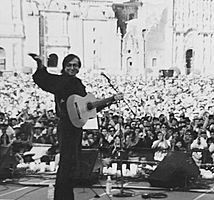Gabino Palomares facts for kids
Quick facts for kids
Gabino Palomares
|
|
|---|---|

Gabino Palomares. Circa 1998. Concert in Mexico City.
|
|
| Background information | |
| Born | May 26, 1950 Comonfort, Guanajuato, Mexico |
| Genres | Nueva canción, canto nuevo, protest song |
| Instruments | Voice, guitar |
| Associated acts | Silvio Rodríguez, Mercedes Sosa, Pete Seeger, Daniel Viglietti, Amparo Ochoa, Óscar Chávez, Los Folkloristas |
Gabino Palomares Gómez (born May 26, 1950, in Comonfort, Guanajuato, Mexico) is a famous Mexican singer, songwriter, and activist. He is known for his role in the nueva canción (new song) movement in Latin America. He also helped start the canto nuevo (new song) movement in Mexico. Other important artists in this movement include Amparo Ochoa, Óscar Chávez, and the group Los Folkloristas. Gabino Palomares wrote "La maldición de Malinche" (Malinche's Curse) in 1978, which became one of the most important songs of the movement. He has written over a hundred songs about social issues, politics, and love.
Contents
Gabino Palomares: Early Life and Music
Gabino Palomares Gómez was born in Comonfort, Guanajuato. He studied chemistry at the Autonomous University of San Luis Potosí. His first show, called Poems and Songs, was a big hit at the university's Song Festivals in 1972.
In 1975, Gabino moved to Mexico City. He began singing in many different places. These included bars, universities, neighborhoods, public squares, and small theaters. Two special places were "El meson de la guitarra" and "La peña Tecuicanime." There, he met Amparo Ochoa and Salvador "Chava" Flores. They became lifelong friends. Amparo Ochoa sang and recorded several of Gabino's songs. These included "La Maldición de Malinche" (1978) and "Quién tiene la voz?" (Who owns the voice?, 1984). Gabino also sang many of Salvador "Chava" Flores' songs. Some of these are on his album Gabino Palomares interpreta a Chava Flores (Gabino Palomares Sings the Songs of Chava Flores, 2010).
Rising to Fame: The New Song Movement
By the late 1970s, Gabino Palomares became a leading artist in both Mexican canto nuevo and Latin American nueva canción. In 1978, he released his first album, La Maldición de Malinche. This album featured some of his most famous songs. These included "A la patria" (To the Homeland, 1978) and "La letanía de los poderosos" (The Powerful's Litany, 1978). Music expert Jan Fairley called "La maldición de Malinche" "surely one of the most important songs of the Americas." Also in 1978, Gabino helped with Felipe Santander's play "El extensionista" (The extensionist). He wrote songs, sang, and acted in it. This led to his album El extensionista (The Extensionist, 1985). In 1980, he released his second album, Fabricando la luz (Manufacturing the Light, 1980).
International Recognition and Tours
In 1982, Gabino Palomares was chosen as the General Secretary of the International Committee of the New Song in Cuba. He held this important role until 1988. This showed how much his music and activism were respected.
From 1980 onwards, Gabino Palomares' career grew even more. He performed in many countries, including Argentina, Cuba, Germany, the U.S., Canada, and Nicaragua. In Mexico, he sang at major venues. These included Palacio de Bellas Artes, Auditorio Nacional, and Teatro de la Ciudad. He also toured all over the country. Between 1984 and 1989, he released several albums. These were Hace como un año (About a Year Ago, 1984), No te creo nada (I don't Believe You at All, 1987), and ¿Qué vamos a hacer? (What Are We Going to Do?, 1989). In 1991, he released Canciones contra la Guerra (Songs Against the War). He wrote this album in response to the U.S. invasion of Iraq.
Later Works and Collaborations
After almost ten years without a new album, Gabino released Historia cotidiana (An Everyday Story, 2000). He continued to perform and work as an activist during this time. This album included "Espejos de mi alma" (Mirrors of my soul, 2000), a song for the EZLN. It also had "Hermosísimo lucero" ("Beautiful Bright Star"), a tribute to his friend Amparo Ochoa.
Gabino Palomares has shared the stage with many great artists. These include Mercedes Sosa, Silvio Rodríguez, Pete Seeger, Daniel Viglietti, Pablo Milanés, and Joan Manuel Serrat.
On August 3, 2012, Gabino Palomares celebrated 40 years in music. Mexico City's Government organized a special concert for him at the Teatro de la Ciudad. On September 30, 2013, he performed at the famous Auditorio Nacional in Mexico City. The concert was called 40 años, Los mismos sueños (40 Years, The Same Dreams). He performed with groups like Quilapayún, Inti-Illimani, Los Folkloristas, and singer-songwriter Daniel Viglietti.
Gabino Palomares: Albums
- La maldición de Malinche, Discos Pueblo, México, 1978, LP.
- Fabricando la luz, Discos Pueblo, México, 1980, LP.
- Hace como un año, Discos Pueblo, México, 1984, LP.
- El extensionista, Discos Plan Joven del CREA, México, 1985, LP.
- No te creo nada, BMG Ariola, México, 1987, LP.
- ¿Qué vamos a hacer?, BMG Ariola, México, 1989, LP.
- Septiembre: Canciones contra la guerra, Ediciones Pentagrama, México, 1991, LP.
- Antología 1, Discos Pueblo, México, 1997, LP.
- Antología 2, Ediciones Pentagrama, México, 1997, LP.
- Historia cotidiana, Ediciones Pentagrama, México, 2000, LP.
- Salimos, Ediciones Pentagrama, México, 2006, LP.
- México a través de su canto, Ediciones Pentagrama, México, 2010, LP.
- Gabino Palomares interpreta a Chava Flores, Ediciones Pentagrama, México, 2010, LP.
See also
 In Spanish: Gabino Palomares para niños
In Spanish: Gabino Palomares para niños

